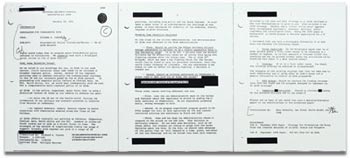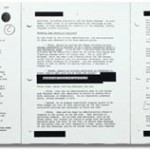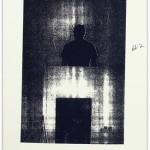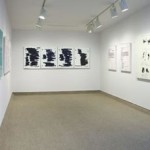By CHRISTIAN HOLLAND
“If you don’t have anything worth saying, don’t say it.”
This was a popular aphorism that the more erudite girls would tell the boys on the elementary school playground when I was growing up. Jenny Holzer has made a whole body of work based on this idea. Her decades of text-based works rely on short pithy quips which are meant to be seen and understood by millions.
For Jenny Holzer: Archive, the artist took her methodology in a different direction by seeking out statements of grave historical significance by government officials in order to show viewers what has already been said. Luckily for us, in government communications, everything said is worth archiving and Holzer took several declassified documents, most of which were already widely publicized by the ACLU, magnified them several times, and screen-printed them onto canvas that had been hand painted in a muted palette of peaches and creams - except when Warhol-esque symbolism called for a bright green or red.
In large bureaucratic institutions, the individual loses significance and the chains of command become nebulous, so Holzer and her minions sought out specific documents where an individual’s action was pivotal within the narrative of events; whether they were war crimes or the bureaucratic missteps leading to a war of dubious intentions. A two page September 16, 2001 memo from then-CIA Director George Tenet with the subject, "We’re at War" was blown up to 33 x 51 inches and printed on a red-painted canvas. A three page January 25, 2001 memo for then National Security Advisor Condoleezza Rice from her deputy Richard C. Clark suggests that they "urgently need... a review on the al Qida (sic) network" was enlarged to the same proportions and printed on a blue-white canvas.
For their titles, most of the works carry the verbatim subject of the memo or official paperwork from which they were copied along with the canvas' color. Tenet’s memo became We’re at War (Red) while a more marked example Postmortem Examination DOD 003146 - DOD 003147 (Green White), a physician’s examination form for a war crime victim, uses the document’s code. This reminds us how insidious such documents can be, and even worse, that they can so easily be forgotten. At Holzer’s request, all of the paintings are available in their original size and color, in PDF copies of the actual documents from which the paintings were made, perhaps to keep us from forgetting that we’re not just dealing with paintings here.
But they are paintings, not ‘extended helical tricolor LED electronic-display signboards' or building sized Wodiczko-esque projections of the same text. Using paintings to portray the documents gives Holzer more control over the works' perceived messages, but they say much less - and say it to an audience that is smaller by several orders of magnitude - in the context of a commercial gallery. Robert Storr’s essay, “Paper Trail,” for the exhibition catalogue of the same name at Cheim & Read and Yvon Lambert gallery in New York, takes great pains to give the paintings contemporary significance and her gesture an apparent polemic. It is not until three quarters of the way through the piece that the Dean of the Yale School of Art begins to actually discuss Holzer; he devotes most of the piece to a critical discussion on the history and organizational psychology surrounding the events which Holzer spotlights with her document blow-ups. He accentuates the politicization of the documents Holzer uses, but Holzer merely turns them into monochromatic “paintings” like Warhol’s “Death and Disaster” series. Storr compares only the visceral quality of Holzer’s works in Archive to Warhol’s works, but the comparison raises the question of how politically effective even his Race Riot pieces were or ever could be.
In the end, what Archive consists of is mini, collectable Holzers. The documents themselves are enlarged, the works, in their both their size and scope, are miniaturized versions of more formative Holzer works. Furthermore, the Barbara Krakow Gallery is not a very apt venue for activism, it is a commercial gallery that sells works for $100k – some of the art in Archive happens to exceed that figure. Wouldn’t a buyer’s $100k donation to the ACLU be more effective than a purchase of one of Holzer’s works? All of this might raise the question: “Does she have anything worth saying?”
- Jenny Holzer, Memorandum for Condoleeza Rice (Blue White), Oil on linen triptych, 2006.
- Jenny Holzer, 001997 (Light Purple Black), Oil on linen triptych, 2007.
- Exhibition view.
"Jenny Holzer: Archive" is on view April 28, 2007 - June 6, 2007 at Barbara Krakow Gallery.
All images are courtesy of the artist and Barbara Krakow Gallery.






